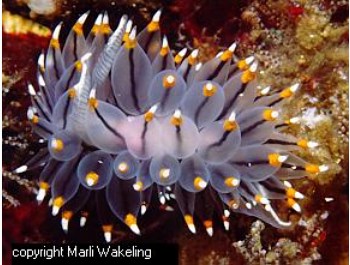
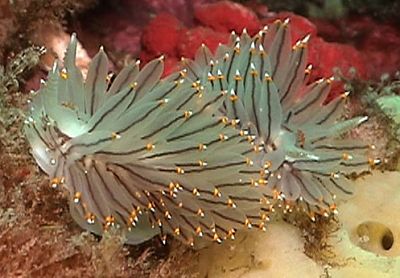
Janolus fuscus
O'Donoghue, 1924
Order: NUDIBRANCHIA
Suborder: ARMININA
Family: Zephyrinidae
DISTRIBUTION
Alaska to California. Also northern Japan [m12680].
PHOTO
Upper: Eastbourne Wall, Keats Island, in Howe Sound, British Columbia, Canada. Photo: Marli Wakeling. Lower: Coronation Island, Alaska, Depth 12m, Length approx 50mm. July, 2002 Photo: Clinton Bauder
In Nth America, Janolus fuscus ranges from the Kenai Peninsula, Alaska (Goddard & Foster, 2002) to central California (Behrens, 1991). It is also known from nthn Japan. It preys on arborescent bryozoans, including Bugula pacifica and species of Tricellaria (Goddard, 1998). It overlaps in distribution with the more southerly Janolus barbarensis, but the two species can be distinguished externally by ceratal differences; Janolus fuscus having unbranched digestive gland ducts and orange and white tips and Janolus barbarensis having branched digestive gland ducts and orange and blue tips (Gosliner, 1982; Behrens, 1991). Janolus fuscus hatch from irregularly coiled, cylindrical egg masses as planktotrophic veligers with type 1 shells 138 microns long (Goddard, 2001).
See message describing parasite, Ismaila belciki.
References:
• Behrens, D.W. (1991) Pacific Coast Nudibranchs. Sea Challengers: Monterey, California.
• Goddard J.H.R. (1984) The opisthobranchs of Cape Arago, Oregon, with notes on their biology and a summary of benthic opisthobranchs known from Oregon. The Veliger, 27: 143-163.
• Goddard, J.H.R. (1998) A summary of the prey of nudibranch mollusks from Cape Arago, Oregon. Opisthobranch Newsletter, 24: 11-14.
• Goddard J.H.R. (2001) Mollusca: Gastropoda. Pp. 86-128. In: A. L. Shanks (ed.), An Identification Guide to the Larval Marine Invertebrates of the Pacific Northwest. Oregon State University Press: Corvallis, Oregon 314 pp.
• Goddard J.H.R. & Foster, N.R. (2002) Range extensions of sacoglossan and nudibranch molluscs to Alaska. The Veliger, 45: 331-336.
• Gosliner, T.M. (1982) The genus Janolus (Nudibranchia: Arminacea) from the Pacific coast of North America, with a reinstatement of Janolus fuscus O'Donoghue, 1924. The Veliger, 24: 219-226.
• O'Donoghue, C.H. (1924). Nudibranchiate mollusca from the Vancouver Island region. 4. Additional species and records. Transactions of the Royal Canadian Institute, Toronto, 15(1): 1-33.
Goddard, J.H.R., 2003 (February 1) Janolus fuscus O'Donoghue, 1924. [In] Sea Slug Forum. Australian Museum, Sydney. Available from http://www.seaslugforum.net/find/janofusc
Related messages
Janolus fuscus from Puget Sound, Washington
April 21, 2006
From: Jan Kocian
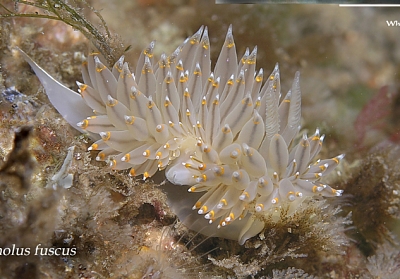
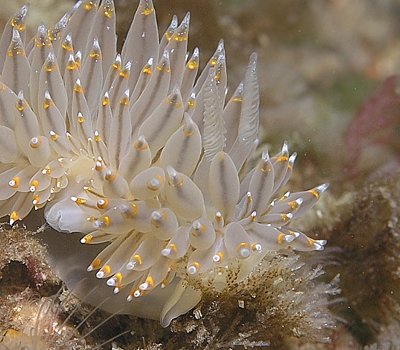
Hi Bill.
In my message about Palio dubia [message #16221] I mentioned that I only noticed it after the dive when I was looking at some photos I took of the common Janolus fuscus on my computer screen, Here are some photos of the Janolus, and below is the photo with the Palio.
Locality: Whidbey Island, Puget Sound, 6 feet, Washington USA, Eastern Pacific Ocean, 30 March 2006, harbor seawall. Length: 22 mm. Photographer: Jan Kocian.
Jan.
honkoc@hotmail.com
Kocian, J., 2006 (Apr 21) Janolus fuscus from Puget Sound, Washington. [Message in] Sea Slug Forum. Australian Museum, Sydney. Available from http://www.seaslugforum.net/find/16399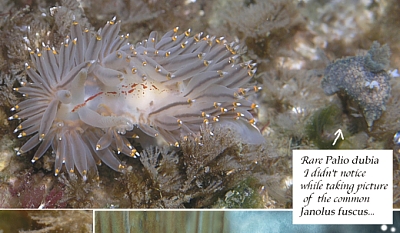
Dear Jan,
Good find - both in the photo and in the field!
Best wishes,
Bill Rudman
Janolus fuscus from northern Japan
July 9, 2004
From: Nishina Masayoshi
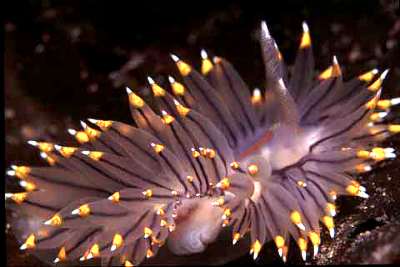
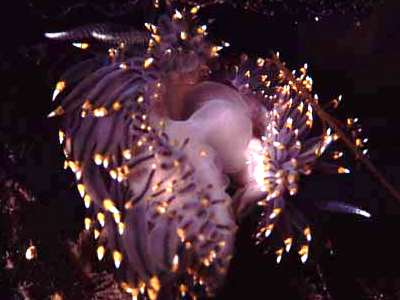
Dear Bill,
In response to Fraser Stanton's message [m12676] here are some images photographed by Fujita at Rausu in Hokkaido Is. in northern Japan. The first description of this species from Japan was by K. Baba (1974) from Sado (an island located in northern part of Sea of Japan). I cannot confirm any further records from that area, however, I noticed that this species is now widely distributed
around coasts of Hokkaido Island. As far as I know, this species was known to local scuba divers at least 20 years ago and they said that it's not uncommon.
DATE: Aug,2000
LOCATION: Rausu,Hokkaido Is.(northernmost island of Japan),East longitude -145,North latitude-44,
LENGTH: 20-30mm
PHOTO BY: Yoshie Fujita
About one year ago, Dr.Jeff Goddard kindly gave me some advice on this species from Japan, and he has agreed that this is conspecific. It is possibly introduced from the Pacific coast of North America.Best Regards,
Nishina Masayoshi
nishina@wips.co.jp
Masayoshi, N., 2004 (Jul 9) Janolus fuscus from northern Japan. [Message in] Sea Slug Forum. Australian Museum, Sydney. Available from http://www.seaslugforum.net/find/12680Thanks Nishina,
I would appreciate a reference to Baba's record of this species in Japan. While it's possible that this species has been introduced to nthn Japan by shipping it is also possible the distribution around the nthn Pacific is a natural phenomenon. As we get a better knowledge of the fauna, quite a number of species appear to have a wide distribution in the northern Pacific down both the coast of Nth America and the coast of Asia. Goddard & Foster (2002) record it from Alaska.
Best wishes
Bill Rudman
Janolus fuscus from Puget Sound
June 28, 2004
From: Fraser Stanton
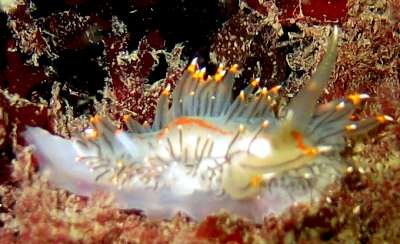
I searched around the SeaSlugForum, but could not find anything that matched this nudibranch. I searched for yellow tip and Pacific northwest [of Nth America] but nothing looked the same. Can you please have a look at this photo and id the nudibranch in it for me? I thought it was an opalescent at first, but after seeing other photos, I changed my mind.
I found it on some kelp near a dock on Whitby Island in 29 feet of water in Puget Sound (Pacific Northwest). At a guess it was about an inch and a quarter long.
I know you must get a million requests like this, but I thank you for
looking anyway.
Thanks,
Fraser
fraserstanton@yahoo.co.nz
Stanton, F., 2004 (Jun 28) Janolus fuscus from Puget Sound. [Message in] Sea Slug Forum. Australian Museum, Sydney. Available from http://www.seaslugforum.net/find/12676Dear Fraser,
This is a form of Janolus fuscus which is found from Alaska to California. All the photos we have on the Forum are of specimens in which the median line that runs from between the rhinophores back down the boody is dark brown. In your animal the line is bright orange. Dave Behrens has a photo of a similar coloured animal in his Pacific Coast Nudibranchs.
Best wishes
Bill Rudman
Additional information on Janolus fuscus
February 3, 2003
From: Jeff Goddard
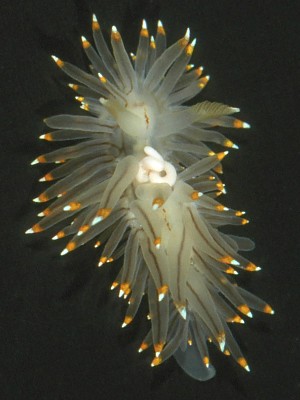
Hi Bill,
Here is some information and a photograph to update the Forum’s Fact Sheet for Janolus fuscus. The photograph is of a specimen, 25 mm long, from Cape Arago, Oregon, July 1987. The cream colored, sausage shaped masses extending from the cardiac region are the paired egg masses of the endoparasitic, splanchnotrophid copepod, Ismaila belciki, which infects Janolus fuscus at prevalences as high as 62% (Belcik, 1981; personal observations). Splanchnotrophids can sterilize their nudibranch hosts and therefore probably significantly impact host populations (Schrodl, 1997). At Cape Arago Dirona albolineata and Triopha catalinae are abundant in the same tidepool habitat at the same time (late summer) as Janolus fuscus; they also prey on the same species of bryozoans (Goddard, 1984, 1998, unpublished observations). The copepod, however, is so far known only from Janolus fuscus (Belcik, 1981) and therefore appears to be strongly host-specific.
Janolus fuscus ranges from the Kenai Peninsula, Alaska (Goddard & Foster, 2002) to central California (Behrens, 1991) and preys on arborescent bryozoans, including Bugula pacifica and species of Tricellaria (Goddard, 1998). It overlaps in distribution with the more southerly Janolus barbarensis, but the two species can be distinguished externally by ceratal differences; Janolus fuscus having unbranched digestive gland ducts and orange and white tips and Janolus barbarensis having branched digestive gland ducts and orange and blue tips (Gosliner, 1982; Behrens, 1991). Janolus fuscus hatch from irregularly coiled, cylindrical egg masses as planktotrophic veligers with type 1 shells 138 microns long (Goddard, 2001).
References:
• Behrens, D.W. (1991) Pacific Coast Nudibranchs. Sea Challengers: Monterey, California.
• Belcik, F.P. (1981) The male of Ismaila monstrosa Bergh, 1867 (Copepoda: Splanchnotrophidae). Crustaceana, 40: 16-25.
• Goddard J.H.R. (1984) The opisthobranchs of Cape Arago, Oregon, with notes on their biology and a summary of benthic opisthobranchs known from Oregon. The Veliger, 27: 143-163.
• Goddard, J.H.R. (1998) A summary of the prey of nudibranch mollusks from Cape Arago, Oregon. Opisthobranch Newsletter, 24: 11-14.
• Goddard J.H.R. (2001) Mollusca: Gastropoda. Pp. 86-128. In: A. L. Shanks (ed.), An Identification Guide to the Larval Marine Invertebrates of the Pacific Northwest. Oregon State University Press: Corvallis, Oregon 314 pp.
• Goddard J.H.R. & Foster, N.R. (2002) Range extensions of sacoglossan and nudibranch molluscs to Alaska. The Veliger, 45: 331-336.
• Gosliner, T.M. (1982) The genus Janolus (Nudibranchia: Arminacea) from the Pacific coast of North America, with a reinstatement of Janolus fuscus O’Donoghue, 1924. The Veliger, 24: 219-226.
• O’Donoghue, C.H. (1924) Notes on the nudibranchiate Mollusca from the Vancouver Island region. 4. Transactions of the Royal Canadian Institute, 15: 1-33.
• Schroedl, M. (1997) Aspects of Chilean nudibranch biology: effects of splanchnotrophid copepod parasitism on Flabellina sp. 1. Opisthobranch Newsletter, 23: 45-47.
Jeff Goddard
goddard@lifesci.ucsb.edu
Goddard, J., 2003 (Feb 3) Additional information on Janolus fuscus. [Message in] Sea Slug Forum. Australian Museum, Sydney. Available from http://www.seaslugforum.net/find/9060Thanks Jeff,
There was so little on the Fact Sheet, your contribution is much more than an 'update'. Your information on the parasite Ismaila is an interesting addition to the information we already have on this genus in South America.
Best wishes,
Bill Rudman
Janolus fuscus from Alaska
August 8, 2002
From: Clinton Bauder

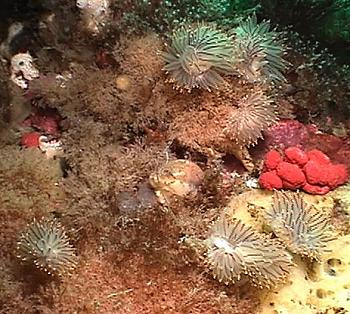
Hi Bill,
More from Coronation Island in Alaska, July, 2002. The wall was absolutely covered in Janolus fuscus. Not sure whether they were eating the yellowish sponge or the hydroids. Depth was maybe 12m and they were about 50mm in length.
Clinton
gecko1@apple.com
Bauder, C., 2002 (Aug 8) Janolus fuscus from Alaska. [Message in] Sea Slug Forum. Australian Museum, Sydney. Available from http://www.seaslugforum.net/find/7687Dear Clinton,
These animals should feed on arborescent bryozoans. I am pretty sure the weedy thing they are on is such a bryozoan.
Cheers,
Bill Rudman
Janolus fuscus from British Columbia
June 4, 2000
From: Marli Wakeling

Dear Bill,
Here is a photo of Janolus fuscus. It is very common in the spring. These animals range from 1 to over 10 cm. in length. They have lamellate rhinophores and a comb like sensory appendage between their rhinophores. This specimen was found on Eastbourne Wall, on Keats Island, British Columbia, Canada. Depth about 60 feet. This specimen was about 5 cm. in length They react to divers by swelling their cerata.
Hope these photos will be of help.
Marli Wakeling
President, 2000
Underwater British Columbia Photographic Society
scubamarli@excite.com
Wakeling, M., 2000 (Jun 4) Janolus fuscus from British Columbia. [Message in] Sea Slug Forum. Australian Museum, Sydney. Available from http://www.seaslugforum.net/find/2498Dear Marli,
Thanks again. I don't think I have ever seen a photo of this species before. Your 'common' species may be boring to you but to the rest of the world they are very interesting. I very much look forward to some more of your wonderful photos.
Best wishes,
Bill Rudman.
